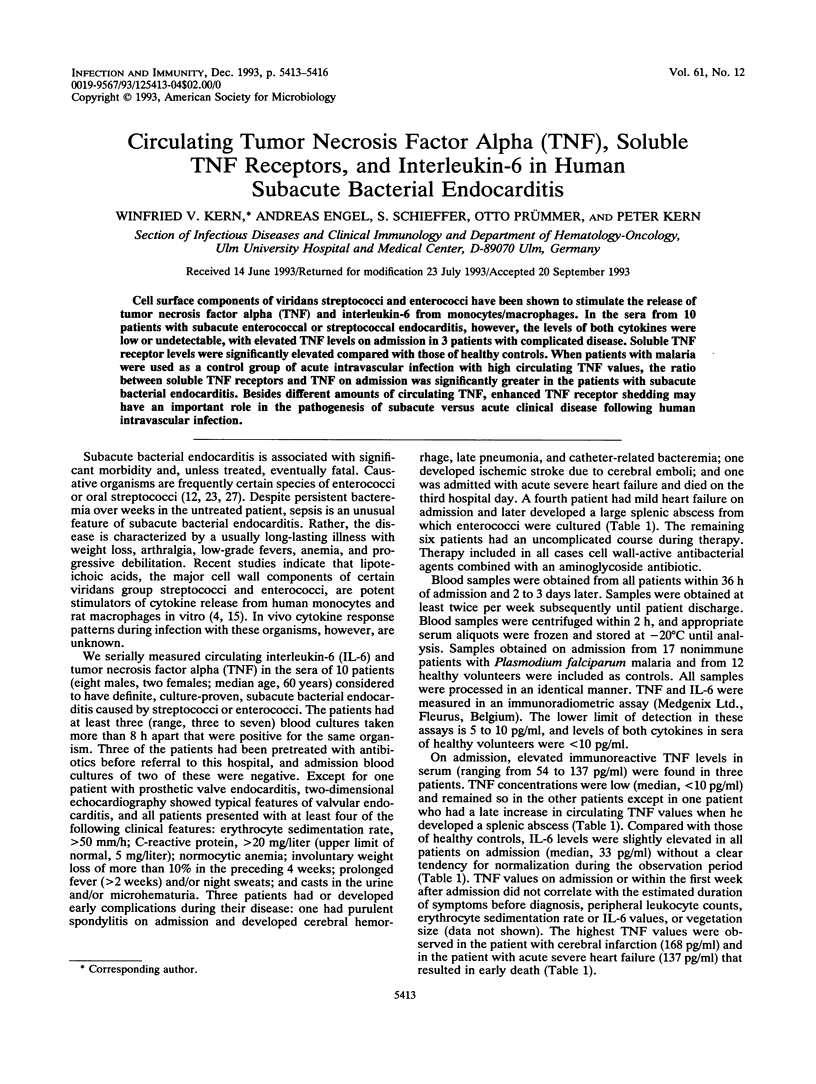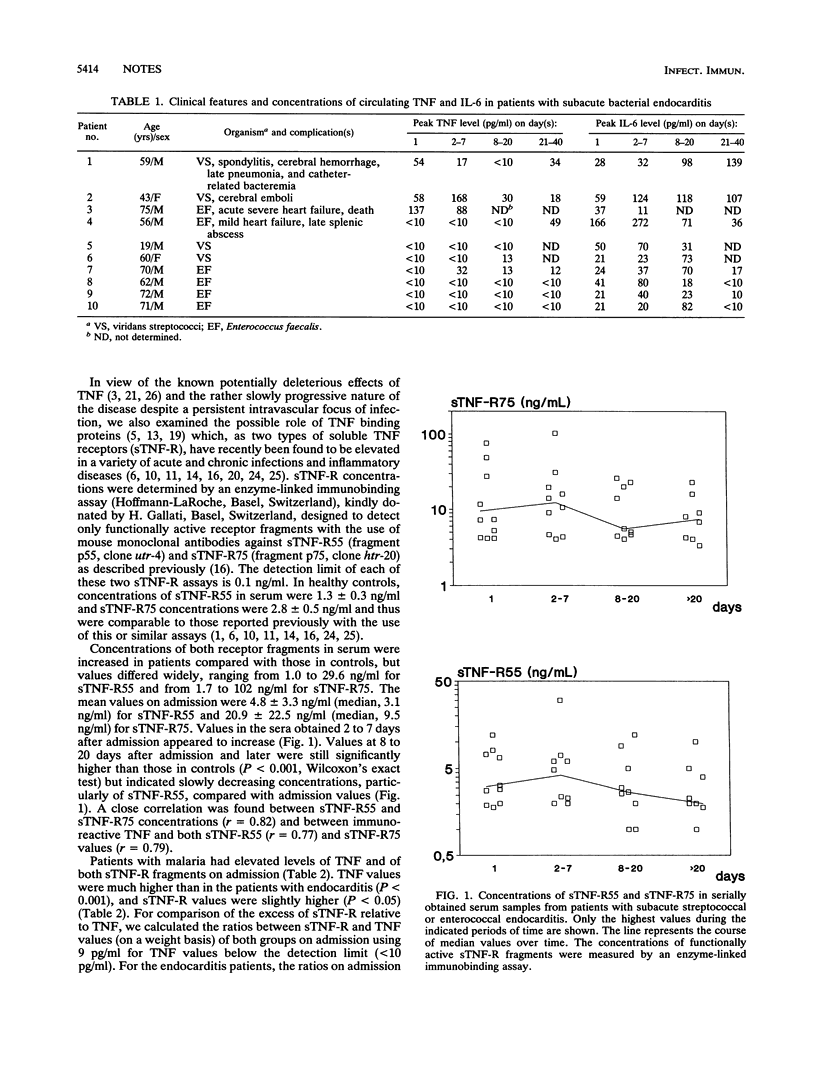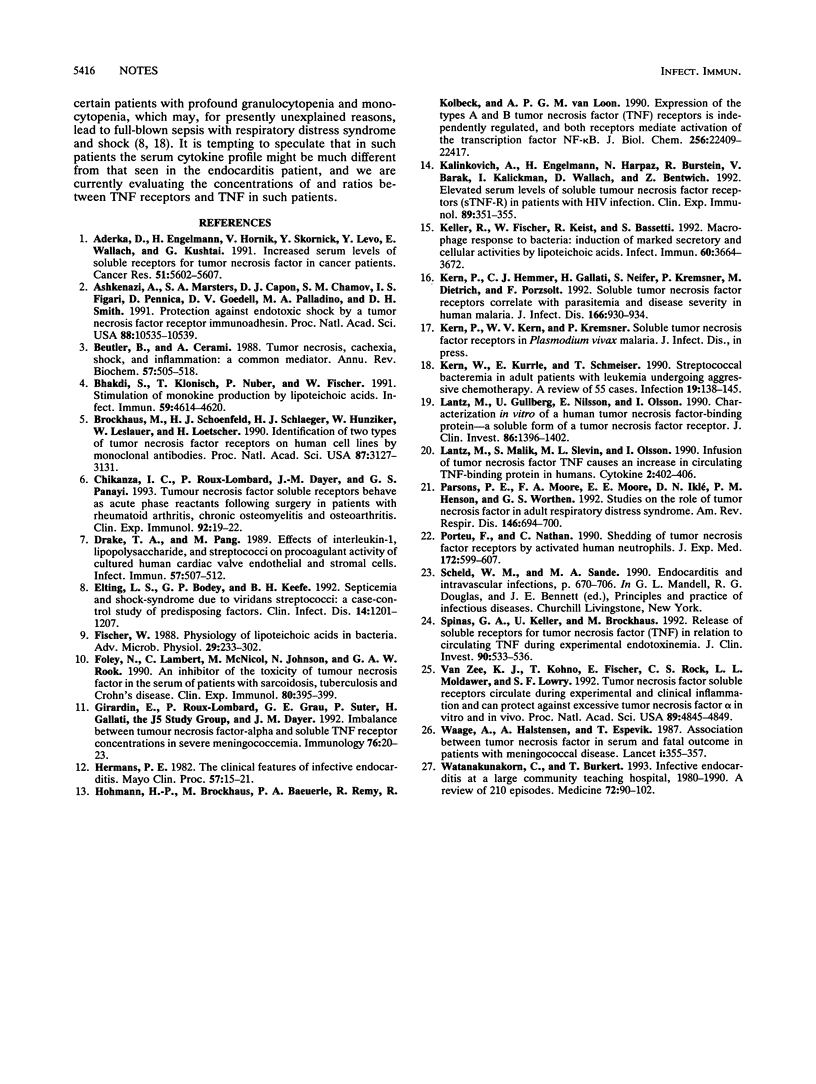Abstract
Cell surface components of viridans streptococci and enterococci have been shown to stimulate the release of tumor necrosis factor alpha (TNF) and interleukin-6 from monocytes/macrophages. In the sera from 10 patients with subacute enterococcal or streptococcal endocarditis, however, the levels of both cytokines were low or undetectable, with elevated TNF levels on admission in 3 patients with complicated disease. Soluble TNF receptor levels were significantly elevated compared with those of healthy controls. When patients with malaria were used as a control group of acute intravascular infection with high circulating TNF values, the ratio between soluble TNF receptors and TNF on admission was significantly greater in the patients with subacute bacterial endocarditis. Besides different amounts of circulating TNF, enhanced TNF receptor shedding may have an important role in the pathogenesis of subacute versus acute clinical disease following human intravascular infection.
Full text
PDF



Selected References
These references are in PubMed. This may not be the complete list of references from this article.
- Aderka D., Englemann H., Hornik V., Skornick Y., Levo Y., Wallach D., Kushtai G. Increased serum levels of soluble receptors for tumor necrosis factor in cancer patients. Cancer Res. 1991 Oct 15;51(20):5602–5607. [PubMed] [Google Scholar]
- Ashkenazi A., Marsters S. A., Capon D. J., Chamow S. M., Figari I. S., Pennica D., Goeddel D. V., Palladino M. A., Smith D. H. Protection against endotoxic shock by a tumor necrosis factor receptor immunoadhesin. Proc Natl Acad Sci U S A. 1991 Dec 1;88(23):10535–10539. doi: 10.1073/pnas.88.23.10535. [DOI] [PMC free article] [PubMed] [Google Scholar]
- Beutler B., Cerami A. Tumor necrosis, cachexia, shock, and inflammation: a common mediator. Annu Rev Biochem. 1988;57:505–518. doi: 10.1146/annurev.bi.57.070188.002445. [DOI] [PubMed] [Google Scholar]
- Bhakdi S., Klonisch T., Nuber P., Fischer W. Stimulation of monokine production by lipoteichoic acids. Infect Immun. 1991 Dec;59(12):4614–4620. doi: 10.1128/iai.59.12.4614-4620.1991. [DOI] [PMC free article] [PubMed] [Google Scholar]
- Brockhaus M., Schoenfeld H. J., Schlaeger E. J., Hunziker W., Lesslauer W., Loetscher H. Identification of two types of tumor necrosis factor receptors on human cell lines by monoclonal antibodies. Proc Natl Acad Sci U S A. 1990 Apr;87(8):3127–3131. doi: 10.1073/pnas.87.8.3127. [DOI] [PMC free article] [PubMed] [Google Scholar]
- Chikanza I. C., Roux-Lombard P., Dayer J. M., Panayi G. S. Tumour necrosis factor soluble receptors behave as acute phase reactants following surgery in patients with rheumatoid arthritis, chronic osteomyelitis and osteoarthritis. Clin Exp Immunol. 1993 Apr;92(1):19–22. doi: 10.1111/j.1365-2249.1993.tb05941.x. [DOI] [PMC free article] [PubMed] [Google Scholar]
- Drake T. A., Pang M. Effects of interleukin-1, lipopolysaccharide, and streptococci on procoagulant activity of cultured human cardiac valve endothelial and stromal cells. Infect Immun. 1989 Feb;57(2):507–512. doi: 10.1128/iai.57.2.507-512.1989. [DOI] [PMC free article] [PubMed] [Google Scholar]
- Elting L. S., Bodey G. P., Keefe B. H. Septicemia and shock syndrome due to viridans streptococci: a case-control study of predisposing factors. Clin Infect Dis. 1992 Jun;14(6):1201–1207. doi: 10.1093/clinids/14.6.1201. [DOI] [PubMed] [Google Scholar]
- Fischer W. Physiology of lipoteichoic acids in bacteria. Adv Microb Physiol. 1988;29:233–302. doi: 10.1016/s0065-2911(08)60349-5. [DOI] [PubMed] [Google Scholar]
- Foley N., Lambert C., McNicol M., Johnson N., Rook G. A. An inhibitor of the toxicity of tumour necrosis factor in the serum of patients with sarcoidosis, tuberculosis and Crohn's disease. Clin Exp Immunol. 1990 Jun;80(3):395–399. doi: 10.1111/j.1365-2249.1990.tb03299.x. [DOI] [PMC free article] [PubMed] [Google Scholar]
- Girardin E., Roux-Lombard P., Grau G. E., Suter P., Gallati H., Dayer J. M. Imbalance between tumour necrosis factor-alpha and soluble TNF receptor concentrations in severe meningococcaemia. The J5 Study Group. Immunology. 1992 May;76(1):20–23. [PMC free article] [PubMed] [Google Scholar]
- Hermans P. E. The clinical manifestations of infective endocarditis. Mayo Clin Proc. 1982 Jan;57(1):15–21. [PubMed] [Google Scholar]
- Hohmann H. P., Brockhaus M., Baeuerle P. A., Remy R., Kolbeck R., van Loon A. P. Expression of the types A and B tumor necrosis factor (TNF) receptors is independently regulated, and both receptors mediate activation of the transcription factor NF-kappa B. TNF alpha is not needed for induction of a biological effect via TNF receptors. J Biol Chem. 1990 Dec 25;265(36):22409–22417. [PubMed] [Google Scholar]
- Kalinkovich A., Engelmann H., Harpaz N., Burstein R., Barak V., Kalickman I., Wallach D., Bentwich Z. Elevated serum levels of soluble tumour necrosis factor receptors (sTNF-R) in patients with HIV infection. Clin Exp Immunol. 1992 Sep;89(3):351–355. doi: 10.1111/j.1365-2249.1992.tb06961.x. [DOI] [PMC free article] [PubMed] [Google Scholar]
- Keller R., Fischer W., Keist R., Bassetti S. Macrophage response to bacteria: induction of marked secretory and cellular activities by lipoteichoic acids. Infect Immun. 1992 Sep;60(9):3664–3672. doi: 10.1128/iai.60.9.3664-3672.1992. [DOI] [PMC free article] [PubMed] [Google Scholar]
- Kern P., Hemmer C. J., Gallati H., Neifer S., Kremsner P., Dietrich M., Porzsolt F. Soluble tumor necrosis factor receptors correlate with parasitemia and disease severity in human malaria. J Infect Dis. 1992 Oct;166(4):930–934. doi: 10.1093/infdis/166.4.930. [DOI] [PubMed] [Google Scholar]
- Kern W., Kurrle E., Schmeiser T. Streptococcal bacteremia in adult patients with leukemia undergoing aggressive chemotherapy. A review of 55 cases. Infection. 1990 May-Jun;18(3):138–145. doi: 10.1007/BF01642101. [DOI] [PubMed] [Google Scholar]
- Lantz M., Gullberg U., Nilsson E., Olsson I. Characterization in vitro of a human tumor necrosis factor-binding protein. A soluble form of a tumor necrosis factor receptor. J Clin Invest. 1990 Nov;86(5):1396–1402. doi: 10.1172/JCI114853. [DOI] [PMC free article] [PubMed] [Google Scholar]
- Lantz M., Malik S., Slevin M. L., Olsson I. Infusion of tumor necrosis factor (TNF) causes an increase in circulating TNF-binding protein in humans. Cytokine. 1990 Nov;2(6):402–406. doi: 10.1016/1043-4666(90)90048-x. [DOI] [PubMed] [Google Scholar]
- Parsons P. E., Moore F. A., Moore E. E., Iklé D. N., Henson P. M., Worthen G. S. Studies on the role of tumor necrosis factor in adult respiratory distress syndrome. Am Rev Respir Dis. 1992 Sep;146(3):694–700. doi: 10.1164/ajrccm/146.3.694. [DOI] [PubMed] [Google Scholar]
- Porteu F., Nathan C. Shedding of tumor necrosis factor receptors by activated human neutrophils. J Exp Med. 1990 Aug 1;172(2):599–607. doi: 10.1084/jem.172.2.599. [DOI] [PMC free article] [PubMed] [Google Scholar]
- Spinas G. A., Keller U., Brockhaus M. Release of soluble receptors for tumor necrosis factor (TNF) in relation to circulating TNF during experimental endotoxinemia. J Clin Invest. 1992 Aug;90(2):533–536. doi: 10.1172/JCI115891. [DOI] [PMC free article] [PubMed] [Google Scholar]
- Van Zee K. J., Kohno T., Fischer E., Rock C. S., Moldawer L. L., Lowry S. F. Tumor necrosis factor soluble receptors circulate during experimental and clinical inflammation and can protect against excessive tumor necrosis factor alpha in vitro and in vivo. Proc Natl Acad Sci U S A. 1992 Jun 1;89(11):4845–4849. doi: 10.1073/pnas.89.11.4845. [DOI] [PMC free article] [PubMed] [Google Scholar]
- Waage A., Halstensen A., Espevik T. Association between tumour necrosis factor in serum and fatal outcome in patients with meningococcal disease. Lancet. 1987 Feb 14;1(8529):355–357. doi: 10.1016/s0140-6736(87)91728-4. [DOI] [PubMed] [Google Scholar]
- Watanakunakorn C., Burkert T. Infective endocarditis at a large community teaching hospital, 1980-1990. A review of 210 episodes. Medicine (Baltimore) 1993 Mar;72(2):90–102. doi: 10.1097/00005792-199303000-00003. [DOI] [PubMed] [Google Scholar]


